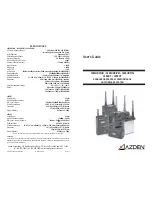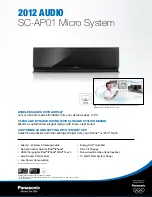
RECEIVER SETUP/USE - 1200URX/AB or 1200URX/VM (continued)
Using either the UP or DOWN button [
l
] the desired receiving fre-
quency or channel number can be set (the included chart shows the
relationship). Tapping the button steps the frequency or channel num-
ber one at a time while pressing and holding the button in moves through
the frequencies or channel numbers rapidly. There are 188 different
frequencies or channel numbers to chose from. Once the desired fre-
quency or channel has been determined be certain to set both the
transmitter and receiver to match.
2
7
D. Power
The POWER ON/OFF switch [
i
] turns the receiver On or OFF. To
conserve battery life, it is best to turn the receiver ON only when it is
actually being used.
E. Output
Select either LINE or MIC [
j
] depending on which input is being used
on the camera.
F. Monitor
This control [
g
] adjusts the output level (MIN to MAX) at the earphone
monitor jack [
d
]. This is a 3.5 mm mono jack.
G. LCD Display
This display [
h
] shows several pieces of information. As discussed
previously, the frequency or channel number is shown. Additionally,
as the deversity receiver chooses which antenna is receiving the best
signal, the ‘A’ or ‘B’ segment of the LCD display will illuminate.
Using either the UP or DOWN button [
l
] the desired receiving fre-
quency or channel number can be set. Tapping the button steps the
frequency or channel number one at a time while pressing and holding
the button moves through the frequencies or channel numbers rapidly.
There are 188 different frequencies or channel numbers to chose from.
Once the desired frequency or channel has been determined be cer-
tain to set both the transmitter and receiver to match.
USING THE 1200BT TRANSMITTER’S CONTROLS AND DISPLAY
A. Power
The POWER ON/OFF switch [
e
] turns the 1200BT On or OFF.
B. Audio
Prior to turning the 1200BT ON it is best to set the AUDIO switch [
g
] to
ST.BY. When ready to transmit, switch to ON. The ST.BY position acts
as a ‘mute’ that maintains the RF signal but turns off the audio.
C. MIC
This 4-pin Hirose connector [
h
] is the microphone input. Azden pro-
duces a number of lapel, head-worn and neck-worn microphones that
are specifically suited for the 1200BT. In addition, other externally pow-
ered (5VDC) electret condenser microphones can be used when they
are properly wired with the correct Hirose connector (pin 1 is for audio
+, pin 2 is not used, pin 3 is for bias voltage and pin 4 is ground). If you
are using the 1200BT as a wireless instrument transmitter the connec-
tions are somewhat different (pin 1 is not used, pin 2 is the audio +, pin
3 is for bias voltage and pin 4 is ground).
D. Input Level Adjustment
This screwdriver adjustment [
♣
] controls the input level of the micro-
phone. Counterclockwise rotation reduces the input gain while clock-
wise rotation increases the input gain.
E. Belt-Clip
The metal belt-clip [
c
] provides a convenient method of attaching the
transmitter to the user.


























